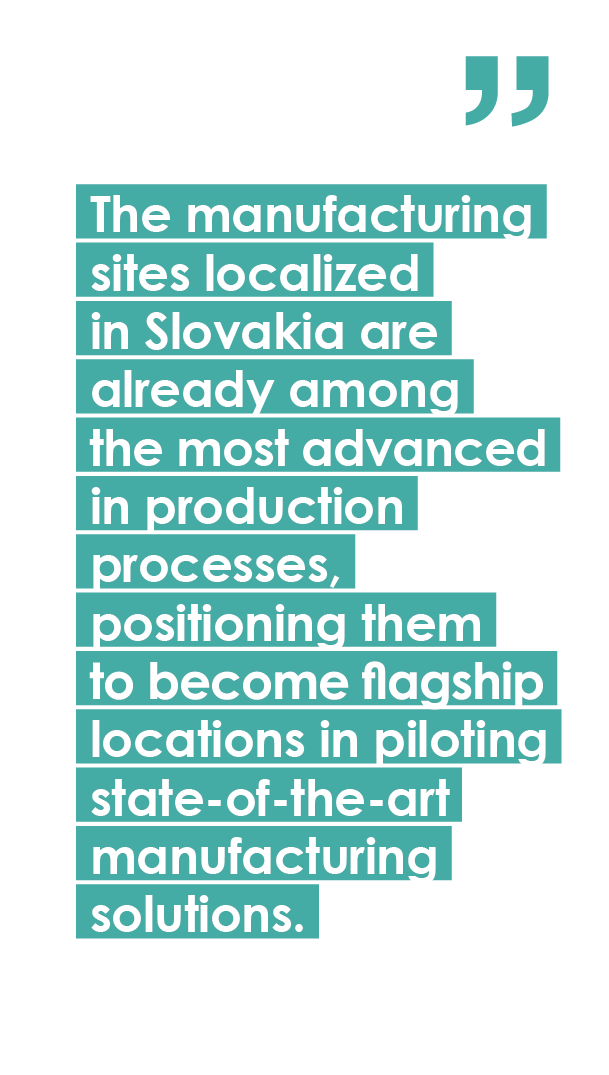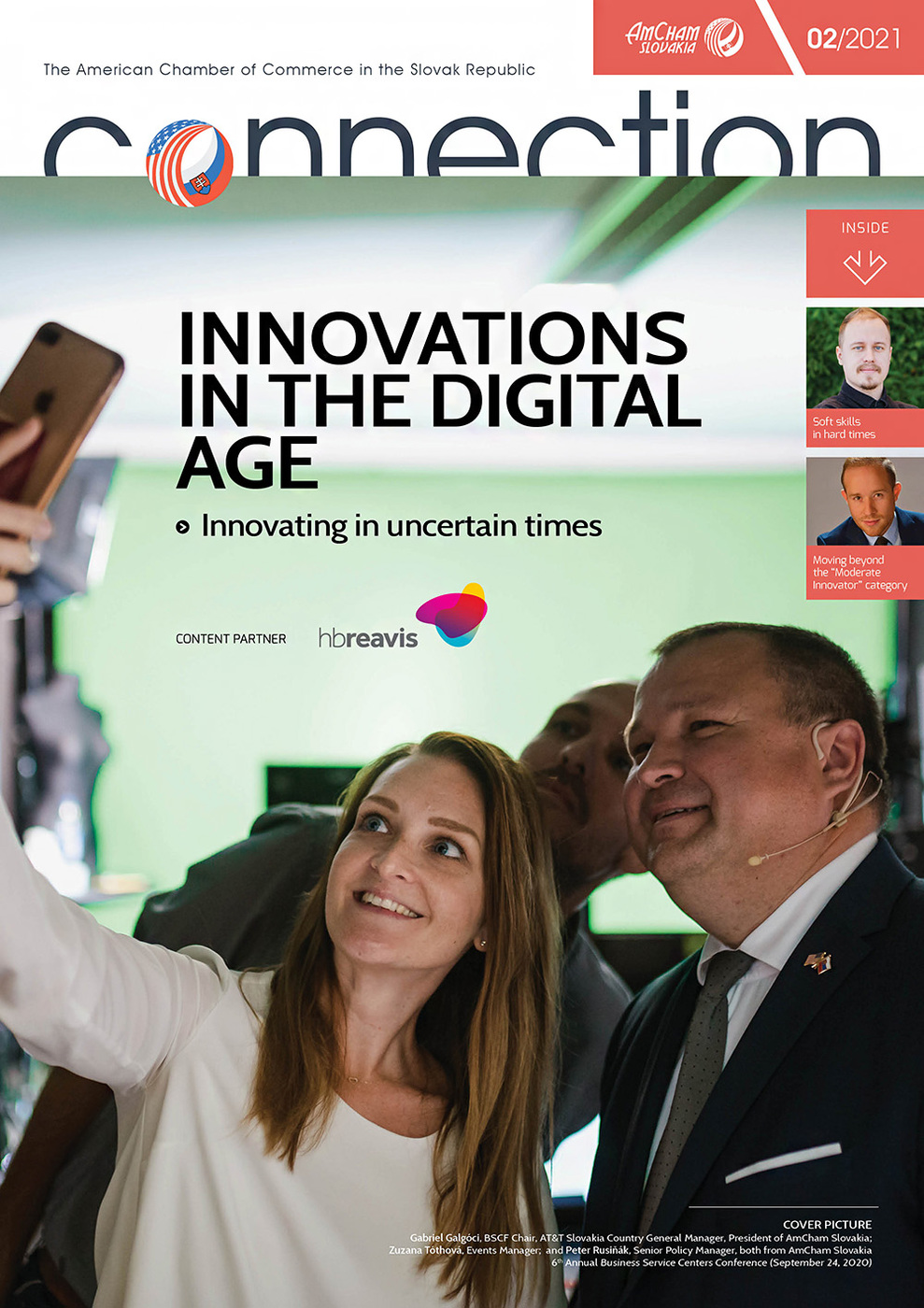Unlike any other industry, the automotive offers Slovakia an unprecedented opportunity to become a technology champion in such a massive and global market. Slovakia is the world leader in terms of cars produced per capita, but R&D and innovation activities within the automotive industry remain underdeveloped and disconnected from the manufacturing base. In combination with autonomous driving technology, the sharing economy will likely reduce the global demand for cars in the upcoming years. Any significant decrease in demand for cars would not go unnoticed.
Globally Advanced Manufacturing
Standing in front of the challenges related to automation across the manufacturing industry, Slovakia needs to find a way to evolve from an economy dependent on volumes of cars produced to a regional technology hub that offers competitive R&D expertise and talent.
The automotive factories located in Slovakia are among the most advanced production facilities globally. This constitutes a window of opportunity for Slovak tech companies to offer solutions, further improving the manufacturing processes, especially regarding the adoption of fully automated and digitalized production solutions.
Efforts to achieve carbon neutrality push car producers to adopt new ecological types of vehicle propulsion. The radical nature of such changes mitigates the dominant position of Original Equipment Manufacturers (OEMs) in the development of combustion engines. Nowadays, people in cities prefer alternative mobility forms over car ownership, creating entirely new segments of urban micro-mobility and data-driven smart mobility.
To capitalize on these opportunities, a complex sectoral collaboration is needed among foreign multinationals, Slovak startups, and the R&D ecosystem. Achieving such collaboration could be formed around innovation & mobility labs that connect traditional stakeholders currently grouped in the Automotive Industry Association of the Slovak Republic, smaller specialized clusters with startups and entrepreneurs, and the university R&D environment.
 New Mobility Trends Create An Opening For Diversification
New Mobility Trends Create An Opening For Diversification
New mobility trends will likely reduce the volume of private vehicle sales. Particularly in urban areas, demand for private ownership of vehicles will drop significantly. With 44% of Slovakia’s industrial base being in automotive manufacturing, any drop in demand for cars will have a negative impact. Moreover, with 277,000 jobs being directly or indirectly connected to automotive manufacturing, automation represents a significant asset and possible threat to the Slovak economy.
Rising demand for mobility services, data connectivity, and software will cause disruption. Traditional OEMs and suppliers will need to adapt to capitalize on changing market trends. For example, the increasing data-connectivity of vehicles will require new technological solutions, and the shift towards autonomous vehicles will create new opportunities in software development. With the shift towards mobility as service, incumbent OEMs and suppliers will be challenged by traditionally non-automotive companies like Apple, Google, Uber, Lyft, and others.
The shifting global trends will put increasing pressure on OEMs and their suppliers to invest more in R&D intensive activities to remain relevant. With a decreasing demand for cars, the industry will prioritize markets with strong R&D capacities. The future disruption in automotive manufacturing will require that Slovakia’s automotive industry graduates from a manufacturing-heavy industry into a more knowledge and R&D intensive one.
Reversing Slovakia’s Vulnerability By Connecting Stakeholders
For Slovakia to maintain its competitiveness in the changing automotive and mobility industry the local market needs to demonstrate competitive potential in terms of R&D capacities and expertise, a supply of high-quality university graduates, and a flourishing startup ecosystem.
The affordable and highly skilled labor force in Slovakia allowed for the introduction of advanced manufacturing processes. The manufacturing sites localized in Slovakia are already among the most advanced in production processes, positioning them to become flagship locations in piloting state-of-the-art manufacturing solutions. Slovak tech companies and universities need to leverage the opportunity and interact more with the automotive manufacturing process and logistics.
More connections between the automotive and mobility sector with the local universities and R&D base need to be brokered. The overall public and private investment in R&D activities in Slovakia needs to increase as well and the local technology startups, researchers, and R&D professionals need to be supported and encouraged to work on collaborative, innovative projects.
Innovation & Mobility Labs Can Be The Answer
To connect the automotive sector with the local R&D base, Slovakia needs to stimulate the formation of collaborative research projects. The concept of innovation & mobility labs is already being pursued by companies like Škoda, PSA, or launched as multi-stakeholder initiatives of the government, OMEs, SMEs, universities, and municipalities. Examples of well-functioning mobility labs include Future Mobility Lab in Ústí nad Labem, Urban Mobility Labs in Austria or RECAR in Hungary. Innovation and mobility labs provide advanced incubation and advisory services that combine business incubation and R&D advisory elements to foster interdisciplinary and cross-sectoral collaboration.
Gradually, the clustering of automotive, mobility, and innovation communities can also increase the utilization of existing research infrastructure and drive public and private investment in strategic research infrastructure. In turn, this can increase the attractiveness of Slovakia to talented professionals, researchers, and startups from abroad.
Shift To Radical Innovation Over Process Automation
The efforts to achieve carbon neutrality are pushing the adoption of electromobility, and eventually hydrogen vehicles. Adopting alternative propulsion engines creates a demand for radical innovation and causes a dramatic change in the production value chain. Electricity will play a major role in this transformation as there is 30-60% of direct electrification rate in transport estimated for the total EU transportation sector by 2050. OEMs already invest billions of euros into electric vehicles.
Electromobility adoption dramatically mitigates entry barriers and makes smaller R&D companies competitive with established players. In this context, more collaboration between OEMs, innovative companies, and the R&D ecosystem can lead to valuable results. Compared to process automation, the critical difference is that OEMs do not identify this area of innovation as essential in Slovakia yet. However, initiatives like Slovak Battery Alliance and Slovak Electric Vehicle Association or R&D and battery production companies like InoBat demonstrate that Slovakia has a strong position to participate in the growing battery business.
Slovakia can also focus on urban and smart mobility trends. Urban mobility is a fast-growing segment ranging from micro-mobility solutions like e-scooters to technologies improving public transportation. Advanced data analytics shapes the smart mobility future, creating opportunities for innovations that improve mobility-related data collection, processing, and interpretation. It is vital to connect the R&D ecosystem with municipalities, public transport providers, and other relevant local stakeholders.

Building An Active Ecosystem
To overcome this barrier, innovative Slovak companies should actively demonstrate their capability to solve global challenges and offer state-of-the-art solutions for ecological transportation and other areas undergoing radical change, such as autonomous vehicle technologies. On top of that, the clustering of the worlds of academia, startups, and industry can yield synergistic effects, helping aggregate greater talent and research base. In turn, these elements will help attract investors who will prioritize Slovakia over other countries due to its research potential and human capital.
The industry has already developed platforms and organizations which could offer opportunities for Slovak innovators. The Automotive Industry Association of the Slovak Republic (AIA SR) groups more than 200 stakeholders, ranging from OEMs to universities. Industry Innovation Cluster (IIC) was founded in 2017 by nine industrial players who directly employ more than 25,000 employees in Slovakia. IIC aims to connect corporates exploring innovative technologies and services to improve transportation options. Smart Mobility Slovakia is a public project which facilitates collaboration among industry, R&D ecosystem, and other relevant stakeholders by providing a web platform for broader matchmaking opportunities. With a collaborative mindset, the existing organizations can already play an important role in connecting the worlds of startups, industry, and academia.
Conclusion
To advance Slovakia’s automotive sector, active and vibrant innovation communities are needed to connect traditional automotive stakeholders, new innovative mobility stakeholders, and the R&D environment.
Connect R&D And Industrial Base
Like assembly lines, manufacturers establish their R&D centers where they find the best and most affordable talent. Slovakia needs to demonstrate competitive potential in terms of R&D capacities and expertise, a supply of high-quality university graduates, and a flourishing startup ecosystem. As a result, key industry players will be more likely to relocate and establish more of their R&D capacities in Slovakia. Therefore, more resources and effort need to be dedicated to maximizing research and innovation collaboration. This is a stepping-stone in transitioning from an economy that only assembles and ships to an economy that develops new innovative products and services with high-added value.
Inclusive And Practical Initiatives
It is essential to provide all kinds of platforms and opportunities to facilitate collaboration among the different stakeholders. Mobility labs could accelerate the best research ideas to commercially and industrially applicable solutions by connecting research teams and idea holders with the industry. Complicated technology transfer rules for research outputs can still discourage private companies from cooperation with research institutions. The government needs to de-risk and motivate private entities to cooperate with the Slovak R&D ecosystem and entrepreneurs. To remain competitive, Slovakia can also adopt schemes that will incentivize companies to innovate and introduce highly efficient technologies. Tax Manifesto 2020, signed by the majority of international Chambers of Commerce in Slovakia, introduced the idea of tax support to help companies with the adoption of new technologies.
Build On Existing Initiatives And Organizations
The automotive industry is mostly concentrated in the Western part of Slovakia. There are also many active organizations and initiatives like Slovak Battery Alliance and Slovak Electric Vehicle Association or R&D and battery production companies like InoBat. These initiatives should be supported and collaborate with more traditional organizations in the automotive ecosystem like The Automotive Industry Association of the Slovak Republic (AIA SR). More clustering under the roof of innovation & mobility lab types of initiatives could help demonstrate that Slovakia has a strong position to participate in the growing battery and new mobility automotive trends.
This text was originally published in “Slovakia: Regional Innovation Ecosystems of the Future: A Vision Beyond 2020”, a report prepared by CIVITTA and EIT Digital. The report advances the Slovak innovation ecosystem’s vision and strategy by promoting the most promising sectors and areas of innovation in the country. It maps and analyzes five emerging entrepreneurial and technology-driven sectors and communities. The full report can be accessed here: https://mailchi.mp/civitta/slovakia-regional-innovation-ecosystems-of-the-future
Jaroslav Leitmann, Innovation Project Manager at CIVITTA Slovakia



Follow us